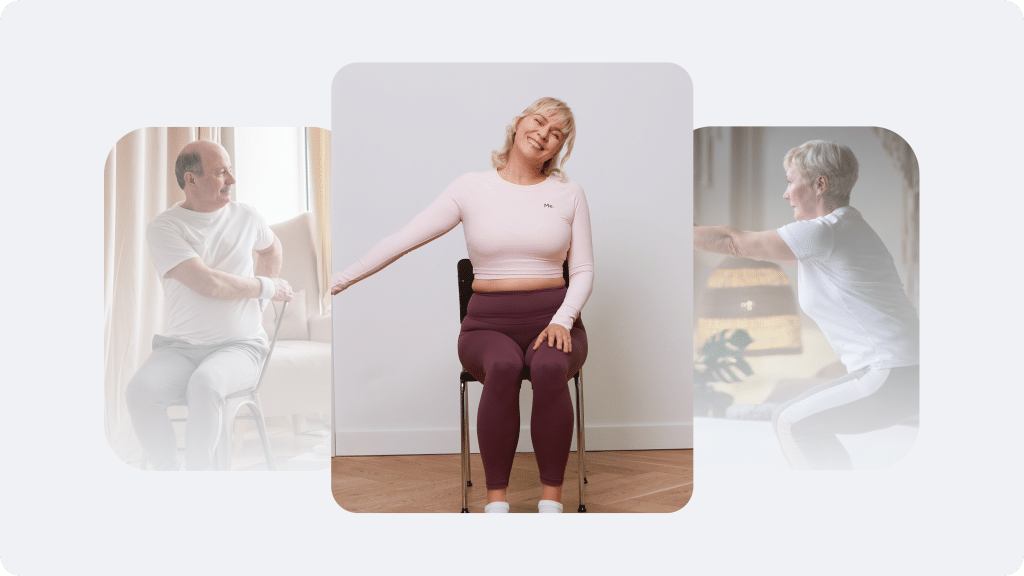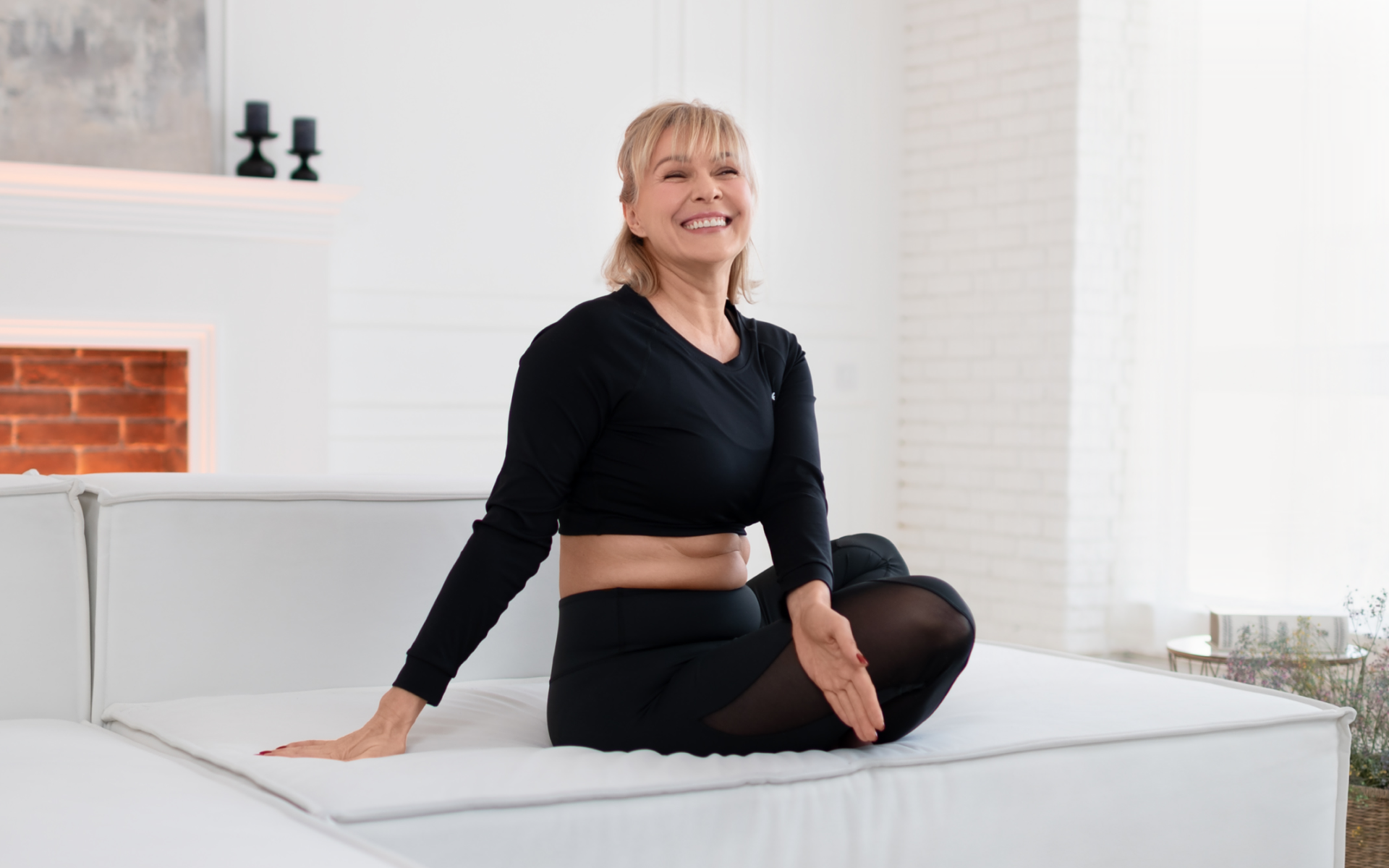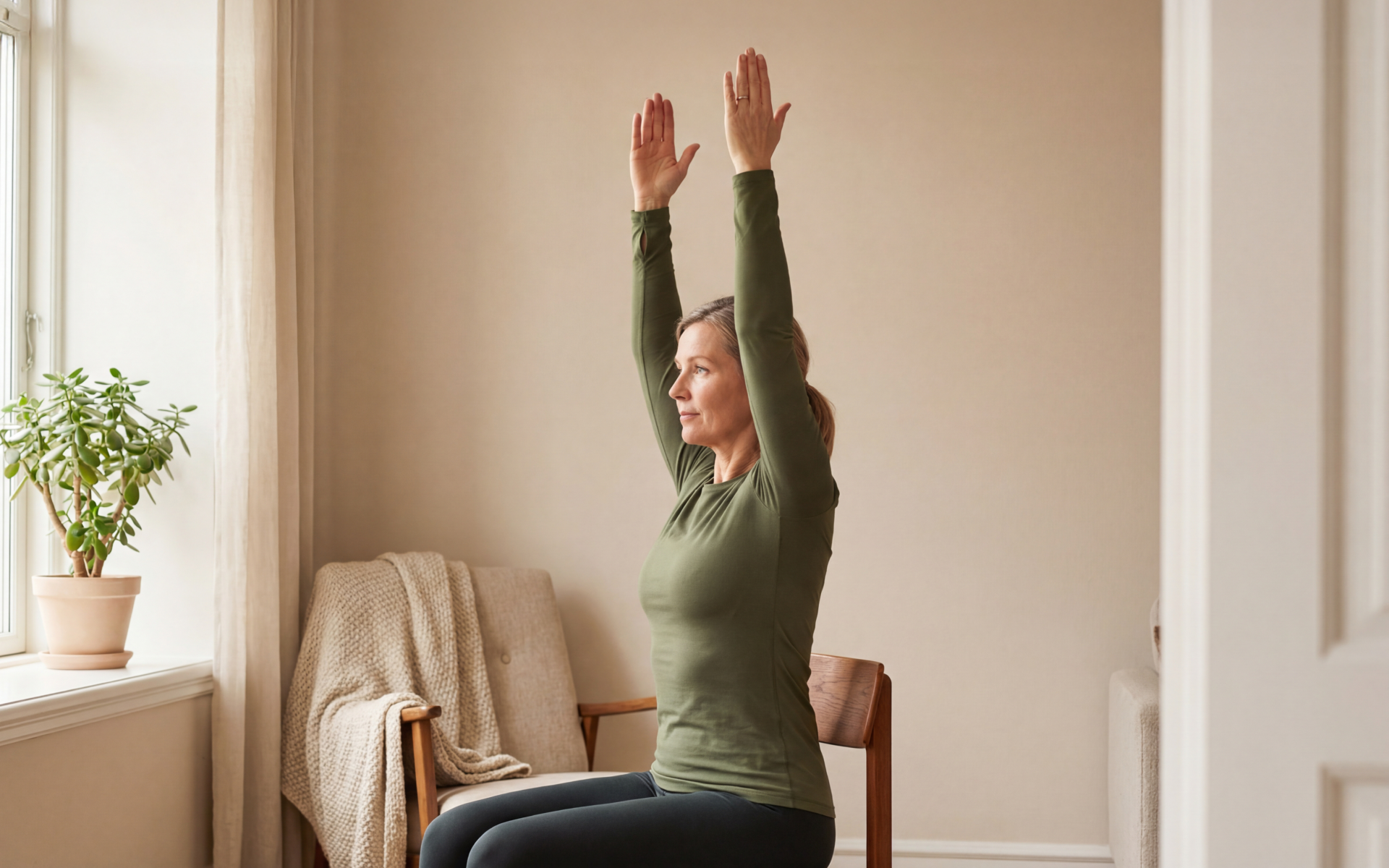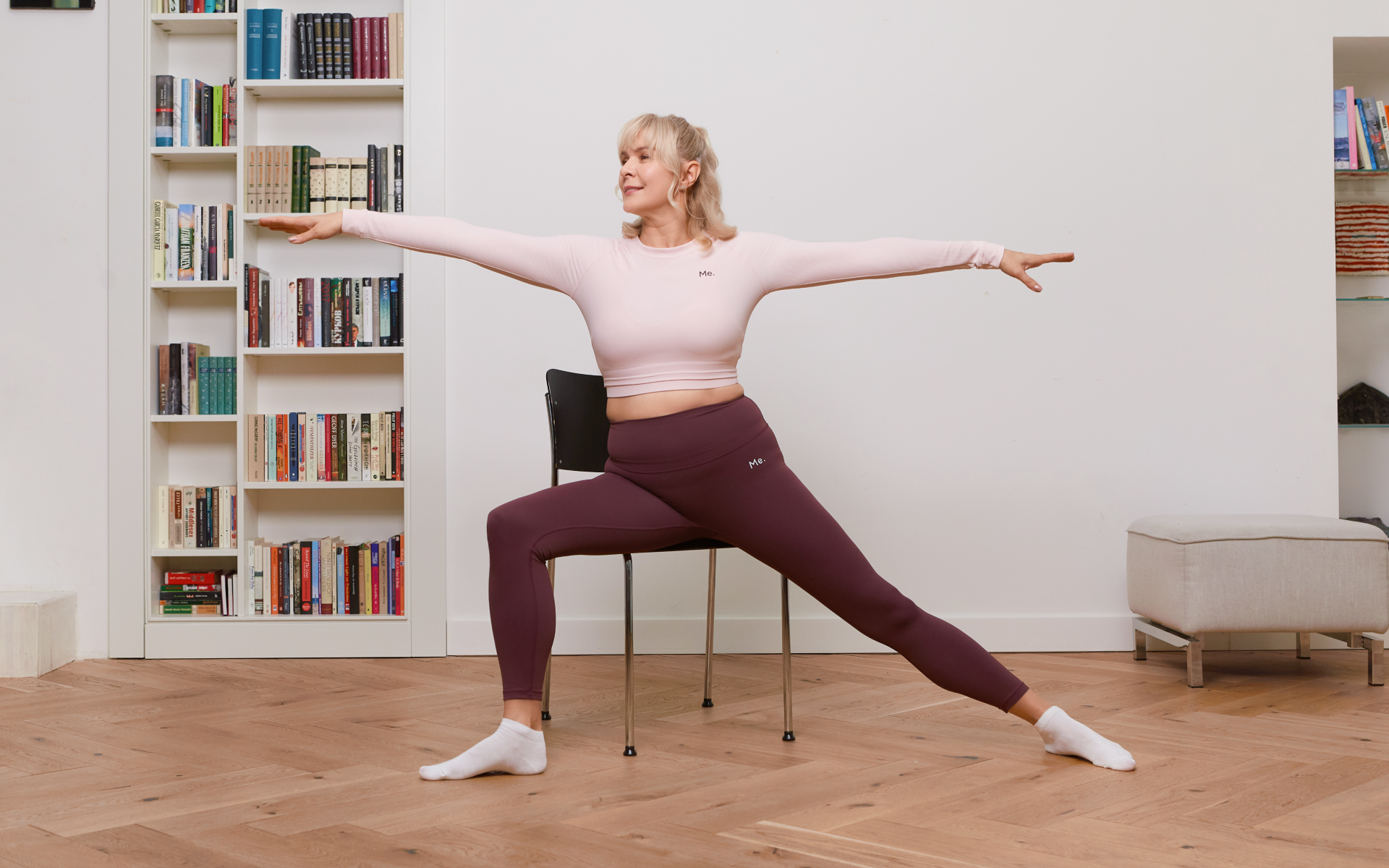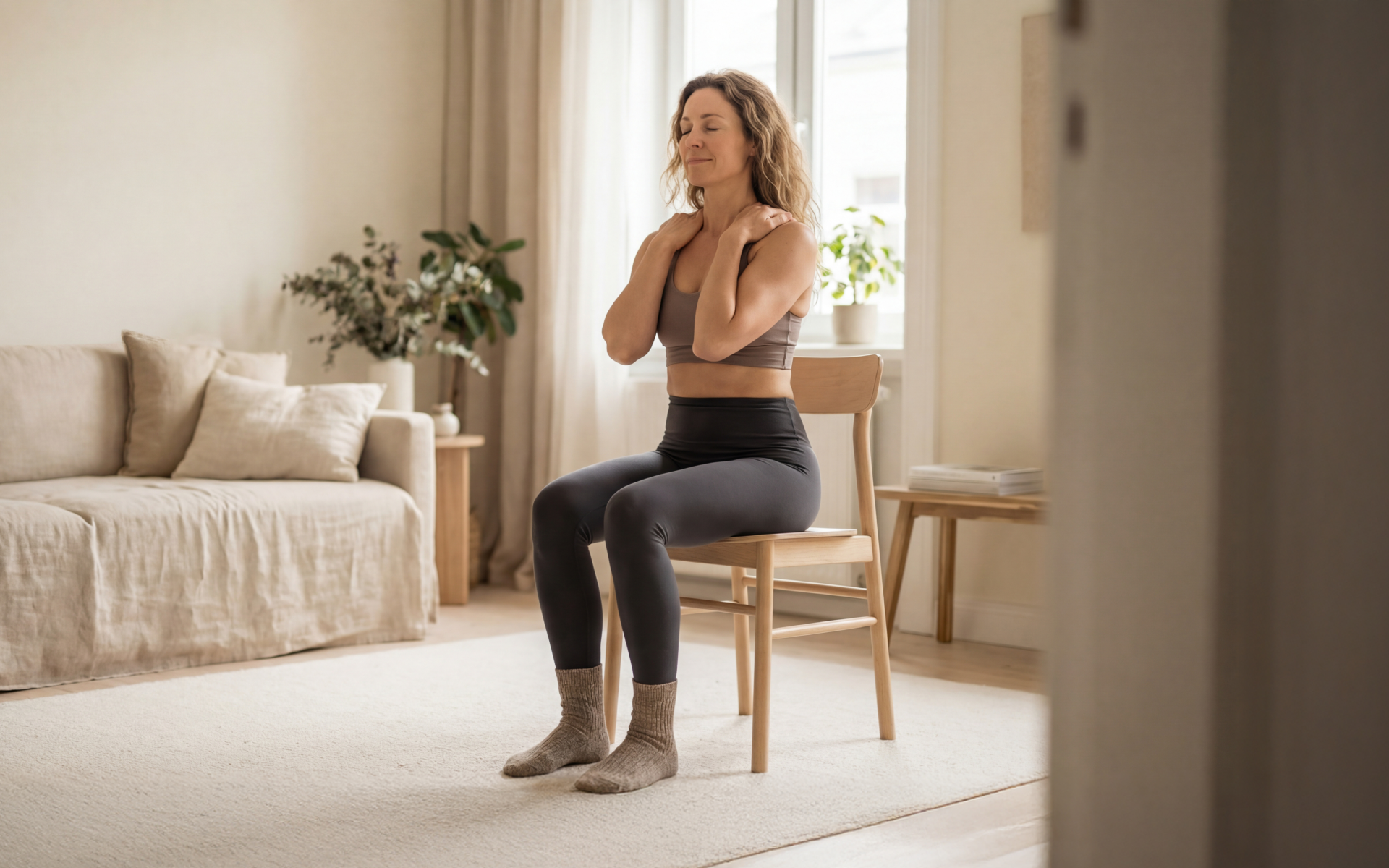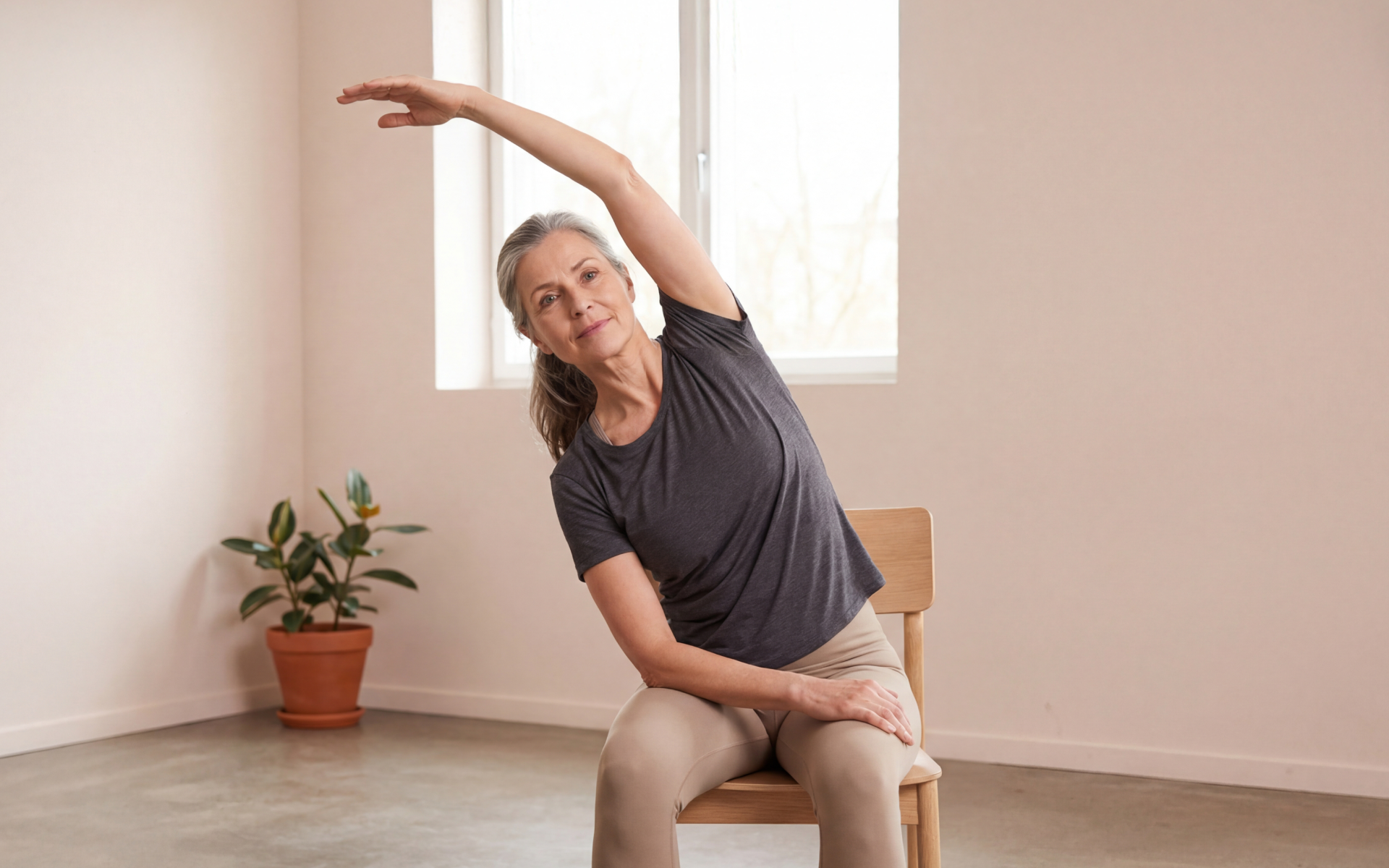A sedentary lifestyle is far from ideal. Many of us spend our working days sitting in front of computers or other screens, which takes a toll on our physical and mental health. Despite this, not everyone can find the time or has the ability to engage in a full exercise routine every day.
Thankfully, there is an easy solution: chair yoga. This form of yoga allows you to reap the benefits of traditional yoga poses while seated on a chair. This could be a perfect option for those with limited mobility, injuries, or anyone looking for a gentle yet effective workout (2)
According to the American Osteopathic Association, chair yoga can improve flexibility, strength, and balance, as well as reduce stress and anxiety (7).
Whether you’re at home or in the office, take a few minutes to try out these 13 easy chair yoga poses.
1. Seated Mountain Pose (Seated Tadasana)
The Seated Mountain Pose, or Seated Tadasana, serves as the foundation for many chair yoga practices. It can help improve posture and align the spine, promoting a sense of stability and grounding.
Benefits: This pose strengthens the back and core muscles, while promoting mindful breathing, which can reduce stress.
Yogic Origins: In traditional yoga, Tadasana is a grounding pose that symbolizes the firmness and stability of a mountain.
Steps:
- Sit up straight with your feet flat on the floor, hip-width apart.
- Keep your knees at a 90-degree angle.
- Place your hands on your thighs, fingers pointing forward.
- Roll your shoulders back and down, lifting your chest slightly.
- Engage your core and lengthen your spine, imagining a straight line from the top of your head down to your tailbone.
- Take deep breaths, holding the pose for several breaths.
2. Seated Forward Bend (Seated Uttanasana)
The Seated Forward Bend, known as Seated Uttanasana, is a gentle stretch that helps relieve tension in the back, shoulders, and hamstrings.
Benefits: This pose aids in stretching the spine and shoulders, promoting relaxation and flexibility.
Yogic Origins: Uttanasana is a classic yoga pose that emphasizes surrender and letting go. It helps to calm the mind and soothe the body .
Steps:
- Sit up straight with your feet flat on the floor, hip-width apart.
- Inhale deeply and raise your arms overhead.
- As you exhale, hinge at your hips and slowly fold forward, reaching your arms toward the floor.
- Keep your back straight and your neck relaxed.
- Hold the pose for a few deep breaths, then slowly rise back to the starting position.
3. Seated Cat-Cow Stretch (Seated Marjaryasana-Bitilasana)
The Seated Cat-Cow Stretch, or Seated Marjaryasana-Bitilasana, involves simple movements that can enhance spinal flexibility and can help to release tension in the body.
Benefits: This pose helps to increase movement of the spine, improve flexibility, and also has the potential to aid in digestion.
Yogic Origins: In yoga, the Cat-Cow sequence is known for combining two poses – Marjaryasana (Cat Pose) and Bitilasana (Cow Pose) – to create flow and harmony in the body.
Steps:
- Sit up straight with your feet flat on the floor, hip-width apart.
- Place your hands on your knees or thighs.
- Inhale and arch your lower back, lifting your chest and looking up toward the ceiling (Cow Pose).
- Exhale and round your spine, tucking your chin towards your chest and drawing your belly in (Cat Pose).
- Continue to flow between these two positions, synchronizing your breath with your movements, for several breaths.
4. Seated Spinal Twist (Seated Ardha Matsyendrasana)
The Seated Spinal Twist, or Seated Ardha Matsyendrasana, is a gentle twist that helps to stretch the back and shoulders.
Benefits: This pose aids in improving spinal flexibility, stimulating digestion, and relieving lower back discomfort.
Yogic Origins: Traditionally, Ardha Matsyendrasana symbolizes the wringing out of toxins, promoting physical and mental clarity.
Steps:
- Sit up straight with your feet flat on the floor, hip-width apart.
- Inhale and lengthen your spine, sitting as tall as possible.
- Place your right hand on the outside of your left thigh.
- Place your left hand behind you on the chair seat for support.
- Exhale and gently twist your torso to the left, looking over your left shoulder.
- Hold the pose for a few deep breaths, then slowly return to the center.
- Repeat on the opposite side.
If you wish to cinch your waist, tone up your bat wings, blast away the muffin top – our fitness app was created to cater to all your needs! BetterMe won’t give excess weight a chance!
5. Seated Side Bend (Seated Parsva Sukhasana)
The Seated Side Bend, or Seated Parsva Sukhasana, involves stretching the sides of your torso, helping to open up the chest and rib cage.
Benefits: This pose enhances flexibility in the spine and intercostal muscles, aiding in better breathing and reducing tension in the waist.
Yogic Origins: Parsva Sukhasana traditionally represents expanding the breath and creating space within the body.
Steps:
- Sit up straight with your feet flat on the floor, hip-width apart.
- Inhale and extend your right arm overhead.
- As you exhale, bend your torso to the left, reaching your right arm over your head.
- Keep your left hand resting on the chair seat for support.
- Hold the pose for several deep breaths, feeling the stretch along your right side.
- Slowly return to the starting position and repeat on the opposite side.
6. Seated Eagle Arms (Seated Garudasana Arms)
The Seated Eagle Arms, known as Seated Garudasana Arms, involves entwining the arms to stretch the shoulders and upper back.
Benefits: This pose helps to improve shoulder flexibility, release tension in the upper back, and increase circulation to the arms and hands.
Yogic Origins: Garudasana symbolizes the eagle and reflects balance, strength, and focus. The arm variation is a seated adaptation to provide similar benefits.
Steps:
- Sit up straight with your feet flat on the floor, hip-width apart.
- Extend your arms in front of you, parallel to the floor.
- Cross your right arm over your left at the elbows.
- Bend both elbows so your fingers point towards the ceiling, and try to bring your palms to touch.
- Lift your elbows slightly and feel the stretch across your shoulders and upper back.
- Hold the pose for several deep breaths, then slowly release and repeat with the opposite arm on top.
7. Seated Crescent Moon (Seated Chandrasana)
The Seated Crescent Moon, or Seated Chandrasana, stretches the sides of the body, improving flexibility and promoting better breathing.
Benefits: This pose can help to increase lung capacity, relieve tension in the rib cage and waist, and improve posture.
Yogic Origins: In yoga, the crescent moon symbolizes growth and expansion. Seated Chandrasana helps to create space in the body and cultivate balance.
Steps:
- Sit up straight with your feet flat on the floor, hip-width apart.
- Inhale and raise both arms overhead, bringing your palms to touch.
- As you exhale, lean to the right, maintaining equal weight on both sit bones.
- Feel the stretch along your left side and hold the pose for several deep breaths.
- Inhale and return to the center.
- Repeat the pose on the left side.
Read more: 21 Day Chair Yoga: Reasons To Add This Challenge To Your Routine
8. Seated Forward Fold (Seated Paschimottanasana)
The Seated Forward Fold, or Seated Paschimottanasana, involves bending forward from the hips to stretch the back of the body.
Benefits: This pose can help to increase flexibility in the spine and hamstrings, reduce stress and anxiety, and calm the mind.
Yogic Origins: Paschimottanasana is derived from Sanskrit words meaning ‘west’ (Paschima) and ‘intense’ (Uttana), representing a strong stretch towards the west or direction of setting sun.
Steps:
- Sit up straight with your feet flat on the floor, hip-width apart.
- Inhale and lengthen your spine.
- Exhale and hinge forward from your hips, reaching for your feet or shins.
- If you cannot reach your feet comfortably, use a strap or towel around the arches of your feet to assist in the stretch.
- Keep your shoulders relaxed and hold the pose for several deep breaths.
- To release, slowly come back to an upright position on an inhale.
- Repeat as desired.
9. Seated Pigeon Pose (Seated Kapotasana)
The Seated Pigeon Pose, or Seated Kapotasana, is a hip-opening stretch that helps to relieve tension in the lower body.
Benefits: This pose can improve hip flexibility, reduce lower back discomfort, and help to open the hip joints.
Yogic Origins: In traditional yoga, Kapotasana represents the pigeon, embodying grace and fluidity. The seated version is accessible and provides the same benefits.
Steps:
- Sit up straight with your feet flat on the floor, hip-width apart.
- Lift your right foot and place your right ankle on your left thigh, just above the knee.
- Flex your right foot to protect your knee joint.
- Sit tall and breathe deeply, feeling the stretch in your right hip.
- Hold the pose for several breaths, then gently release and switch to the opposite side.
10. Seated Upward Salute (Seated Urdhva Hastasana)
The Seated Upward Salute, or Seated Urdhva Hastasana, involves a simple overhead stretch that helps to energize the body and improve posture.
Benefits: This pose can help increase spinal flexibility, elongate the spine, and open the chest, facilitating better breathing. It’s an excellent way to counteract the effects of prolonged sitting.
Yogic Origins: Urdhva Hastasana translates to “upward hand pose” and is often used as a preparatory posture in yoga sequences. It symbolizes reaching upwards towards the sky, evoking a sense of openness and expansiveness.
Steps:
- Sit up straight with your feet flat on the floor, hip-width apart.
- Inhale deeply and raise both arms overhead, bringing your palms to touch or keeping them shoulder-width apart.
- Keep your shoulders relaxed and away from your ears as you lift your chest.
- Hold the stretch for a few deep breaths, feeling the length in your spine.
- Exhale and gently lower your arms to your sides.
11. Seated Happy Baby Pose (Seated Ananda Balasana)
The Seated Happy Baby Pose, or Seated Ananda Balasana, is a playful and gentle stretch that helps to open the hips and relieve lower back tension.
Benefits: This pose aids in stretching the inner thighs, groin, and hamstrings while simultaneously releasing tension in the lower back. It promotes a sense of relaxation and joy.
Yogic Origins: Ananda Balasana translates to “blissful baby pose.” It mimics the joyful and carefree way babies often lie on their backs, connecting practitioners to a sense of childlike happiness and relaxation.
Steps:
- Sit up straight with your feet flat on the floor, hip-width apart.
- Bring your knees towards your chest, holding onto your shins or ankles.
- Flex your feet and gently move your knees wider apart, mimicking the position of a baby grabbing their feet.
- Keep your spine elongated and your shoulders relaxed.
- Hold the pose for several deep breaths, feeling the stretch in your inner thighs and lower back.
- Release the pose and return to the seated position.
BetterMe is your fast-track ticket to a long-lasting weight loss! Tailor your fitness journey and maximize your results with just a couple of swipes!
12. Seated Camel Pose (Seated Ustrasana)
The Seated Camel Pose, or Seated Ustrasana, involves a gentle backbend that helps to open the chest and improve spinal mobility.
Benefits: This pose stretches the front of the body, including the chest, abdomen, and hip flexors. It can also help to strengthen the back muscles and improve posture.
Yogic Origins: Ustrasana, derived from the Sanskrit word for “camel,” symbolizes resilience and strength. The backbend in this pose mirrors the proud posture of a camel, encouraging practitioners to embrace openness and courage.
Steps:
- Sit up straight with your feet flat on the floor, hip-width apart.
- Place your hands on your lower back with fingers pointing downward for support.
- Inhale and lift your chest, gently arching your back.
- As you exhale, press your hands into your lower back and reach your heart towards the sky.
- Keep your chin slightly tucked or let your head gently fall back if comfortable.
- Hold the pose for a few deep breaths, then slowly return to an upright position on an inhale.
- Release your hands and rest for a moment before repeating if desired.
13. Seated Tree Pose (Seated Vrksasana)
The Seated Tree Pose, or Seated Vrksasana, is a balancing pose that helps improve focus and stability while opening the hips.
Benefits: This pose can enhance concentration, balance, and alignment. It also stretches the hips, can work to strengthen the legs, and encourages a sense of grounding and calm.
Yogic Origins: Vrksasana translates to “tree pose,” representing stability and rootedness. This pose embodies the qualities of a tree – grounded yet reaching upwards, which symbolizes growth and balance.
Steps:
- Sit up straight with your feet flat on the floor, hip-width apart.
- Place your left foot flat on the floor and bend your right knee, bringing the sole of your right foot to rest against your left inner thigh or calf.
- Make sure your left foot remains firmly grounded as you find your balance.
- Inhale and lengthen your spine, growing tall like a tree.
- Bring your palms together in front of your heart in a prayer position (Anjali Mudra), or raise your arms overhead with palms facing each other for a deeper stretch.
- Keep your shoulders relaxed and away from your ears, maintaining a deep, steady breath.
- Hold the pose for several breaths, feeling rooted through your grounded foot and lifted through your spine.
- To release, lower your arms and gently place your right foot back on the floor.
- Repeat the pose on the opposite side, balancing your practice.
Is Chair Yoga Good for Beginners?
Chair yoga is good for beginners, as it tends to be easier than traditional yoga for those who may have mobility or balance limitations. It allows individuals to experience the benefits of yoga without having to get up and down from the floor, making it accessible for most ages and abilities.
Chair yoga can also be a great starting point for those who are new to yoga or recovering from an injury, as it offers gentle movements and modifications that can be tailored to individual needs. It’s also a great option for those who have a sedentary lifestyle or spend a lot of time sitting at a desk, as it can counteract the negative effects of prolonged sitting (2).
In addition to physical benefits, chair yoga can also provide mental and emotional benefits such as stress relief, improved focus and concentration, and increased mindfulness (9).
Overall, chair yoga is an excellent choice for beginners looking to experience the benefits of yoga in a safe and accessible way. With regular practice, individuals may eventually progress to more traditional forms of yoga if they desire.
Is Chair Yoga Difficult?
Chair yoga can be modified to accommodate all levels of difficulty, making it suitable for beginners and experienced practitioners alike. Some poses may be more challenging than others, but modifications and the use of a chair for support make the practice accessible to a majority of people .
If you are new to yoga or dealing with physical limitations, it’s recommended to start with simple stretches and gradually work your way up to more advanced poses as your body becomes stronger and more flexible. But always remember to contact a medical professional before starting on any exercise program. This is the best way to be sure that your body is capable of handling the movements involved in any exercise.
Read more: Unlocking Relaxation: The Magic of Restorative Chair Yoga
FAQs
What Is The Easiest Pose In Yoga?
The easiest pose in yoga is subjective; it can vary based on an individual’s physical abilities and experience with yoga. Some people may find seated poses, such as Easy Pose (Sukhasana) or Seated Forward Fold (Paschimottanasana), to be the easiest, while others may find standing poses like Mountain Pose (Tadasana) or Warrior I (Virabhadrasana I) to be more accessible. It’s important to listen to your body and choose poses that feel comfortable for you.
How Can I Make My Chair Pose Easier?
You can make Chair Pose (Utkatasana) easier by modifying the pose to suit your body’s needs. Here are a few ways to modify Chair Pose:
- Place a block or cushion under your heels if you have tight calf muscles.
- If it’s challenging to keep your arms extended, bring your hands into a prayer position in front of your heart.
- Use a chair for support, holding onto the backrest with one or both hands as needed.
- Instead of coming into a full squat, try bending your knees slightly and keeping your feet flat on the floor.
Remember to listen to your body and only go as far as is comfortable for you. As you continue to practice, your strength and flexibility will likely improve, making the full expression of Chair Pose more accessible.
If you have any injuries or limitations, it’s always best to consult with a certified yoga teacher or a medical professional for personalized modifications and guidance.
Does Chair Yoga Count As Exercise?
Yes, chair yoga is a form of exercise just like traditional yoga. According to the Merriam-Webster dictionary, exercise is defined as “bodily exertion for the sake of developing and maintaining physical fitness (3).”
Chair yoga involves gentle stretches, strengthening poses, and mindful breathing exercises that can improve overall physical fitness. Regular practice can help increase range of motion, build strength and balance, and promote relaxation (5).
How Many Times a Week Should You Do Chair Yoga?
You should do chair yoga at least 2-3 times a week to reap its benefits. However, you can practice chair yoga daily if desired, as it is gentle and low impact on the body. Consistency is key when it comes to gaining physical and mental benefits from any form of exercise. As always, listen to your body and make adjustments as needed.
Does Chair Yoga Really Work for Weight Loss?
Chair yoga expends less energy (calories) than other forms of yoga, making it less effective for weight loss compared to more vigorous styles. For weight loss, you will want to be burning more calories than you are consuming in a day. From a purely caloric viewpoint, traditional yoga may be the better option.
However, regular chair yoga practice can contribute to overall weight management by promoting mindfulness and reducing stress (10), which can lead to healthier eating habits and improved sleep – both of which are essential for maintaining a healthy weight (1) (8).
Additionally, strength-building poses in chair yoga can help increase muscle mass, which can aid in boosting metabolism and burning more calories throughout the day (6).
So, while chair yoga may not be as effective for weight loss as other forms of exercise, it can still play a role in supporting overall wellness and healthy lifestyle habits.
Is 20 Minutes of Yoga a Day Enough?
20 minutes of yoga a day beats no yoga at all! It may not seem like a lot of time, but even a short daily practice can provide numerous benefits. A regular 20-minute yoga routine can help improve flexibility, increase strength and balance, relieve tension and stress, and promote mindfulness (4).
If you have more time available, you can always extend your practice or supplement it with other forms of exercise. Remember to listen to your body and honor its needs – some days may call for longer sessions while on others shorter ones will be sufficient. The most important thing is consistency in your practice for long-term benefits.
The Bottom Line
These easy chair yoga poses can be done at home, even while sitting at your desk or during a break at work. You don’t need any fancy equipment, and modifications can be made to suit your individual needs and abilities. With regular practice, chair yoga can improve physical fitness, mental well-being, and overall quality of life.
DISCLAIMER:
This article is intended for general informational purposes only and does not serve to address individual circumstances. It is not a substitute for professional advice or help and should not be relied on for making any kind of decision-making. Any action taken as a direct or indirect result of the information in this article is entirely at your own risk and is your sole responsibility.
BetterMe, its content staff, and its medical advisors accept no responsibility for inaccuracies, errors, misstatements, inconsistencies, or omissions and specifically disclaim any liability, loss or risk, personal, professional or otherwise, which may be incurred as a consequence, directly or indirectly, of the use and/or application of any content.
You should always seek the advice of your physician or other qualified health provider with any questions you may have regarding a medical condition or your specific situation. Never disregard professional medical advice or delay seeking it because of BetterMe content. If you suspect or think you may have a medical emergency, call your doctor.
SOURCES:
- Adequate sleep to improve the treatment of obesity (2012, ncbi.nlm.nih.gov)
- Chair Yoga (2021, journals.lww.com)
- Exercise Definition & Meaning – Merriam-Webster (n.d., merriam-webster.com)
- Exploring the therapeutic effects of yoga and its ability to increase quality of life (2011, ncbi.nlm.nih.gov)
- Exploring the therapeutic effects of yoga and its ability to increase quality of life (2011, ncbi.nlm.nih.gov)
- Increasing muscle mass to improve metabolism (2013, ncbi.nlm.nih.gov)
- Just Say Om: How Yoga Can Help Prevent and Manage Back Pain (2017, osteopathic.org)
- Optimal Diet Strategies for Weight Loss and Weight Loss Maintenance – PMC (2020, ncbi.nlm.nih.gov)
- Reducing Stress with Yoga: A Systematic Review Based on Multimodal Biosignals (2023, ncbi.nlm.nih.gov)
- Yoga in the Management of Overweight and Obesity (2013, journals.sagepub.com)


